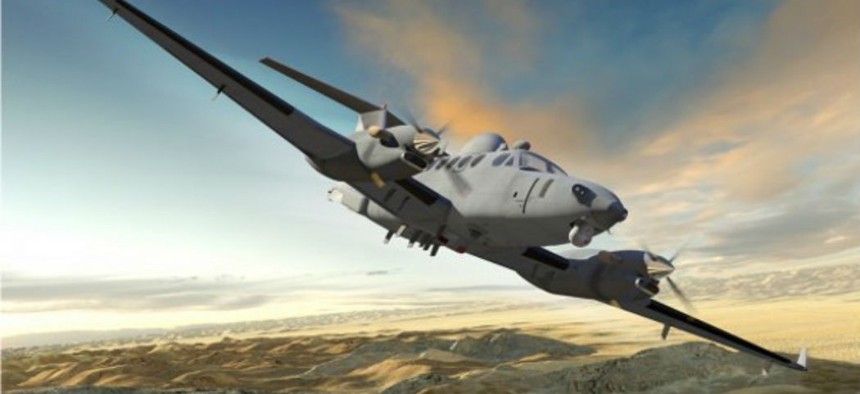Army EMARSS connects with ground-based intel
An emerging Army surveillance plane networks on-board sensors with a ground intelligence system.
The Army is testing a next-generation surveillance plane engineered to identify enemy targets quickly from the air with a high-tech datalink to connect on-board sensors and computers with a multi-source ground-based intelligence system.
The Army’s Enhanced Medium Altitude Reconnaissance and Surveillance System (EMARSS) is a fixed-wing surveillance plane with cameras, software, antennas, intelligence databases and electronic equipment.
The aircraft conducts intelligence, surveillance and reconnaissance missions to identify targets of interest, enemy movement and other ground developments.
A key advantage of EMARSS is that it is connected to the Army's ground-based intelligence database called Distributed Common Ground System – Army (DCGS-A).
“You're bringing the ability not only to detect and exploit the target, but then, also to process all that information and get it out to the people who need it, so that they can take the appropriate action,” said Lt. Col. Sean M. Smith, product manager for Medium Altitude Reconnaissance and Surveillance Systems.
DCGS-A is a comprehensive integrated intelligence data repository, able to compile, organize, display and distribute information from more than 500 data sources. DCGS-A incorporates data from a wide array of sensors, including space-based sensors, geospatial information, signal and human intelligence sources.
By having a datalink with information from the ground-based DCGS-A, flight crews on board EMARSS will be able to use display screens and on-board electronics to receive and view intelligence information in real-time pertaining to their area of operations.
The EMARSS aircraft is configured to integrate a range of sensor packages such as Electro-Optical/Infrared cameras, full-motion video cameras and an imaging sensor technology known as Wide Area Surveillance System able to identify and produce images spanning over a given area of terrain, Army acquisition officials explained.
EMARSS Follow-On Operational Test and Evaluation is coming up this month at Fort Huachuca, Ariz., Smith said.
The Army is also integrating EMARSS with several cutting-edge technologies, to include a Northrop Grumman-built Vehicle and Dismounted Exploitation Radar (VADER) radar imaging technology. VADER uses Synthetic Aperture Radar (SAR) and Ground Moving Target Indicator (GMTI).
GMTI is a radar imaging technology able to detect moving vehicles and SAR is a radar system able to paint an image or picture of the ground showing terrain, elevation and nearby structures, Army developers said.
Smith explained that Army developers plan to test several different EMARSS variants. The “G” model is referred to as a Wide-Area Surveillance Configuration.
“You have the EMARSS-G which is geospatial. There are two types of Gs, you have one that provides LIDAR, and then the other one provides wide-area sensor capability,” Smith said.
Some of the technology being used includes a wide-area surveillance aircraft called “Constant Hawk.”
An EMARSS-M variant uses multi-intelligence sensors, including full-motion video. The “V” version is similar to the “M” but has the VADER radar which performs GMTI and dismount moving target indicator, Smith said.
The Army plans to ultimately field up to 24 EMARSS aircraft, he added.
Smith said at least four EMARSS planes are currently deployed for operational missions in the SOUTHCOM and AFRICOM theaters.
Some of the EMARSS technology has already been used in operational service as part of an effort to assess the technology and refine requirements for the eventual program of record aircraft.
The initial planes, called a Quick Reaction Capability, include an earlier version of the upgraded EMARSS called simply the MARSS - Medium Altitude Reconnaissance and Surveillance System. Some of these MARSS aircraft are now being modified with upgrades to become EMARSS platforms.





